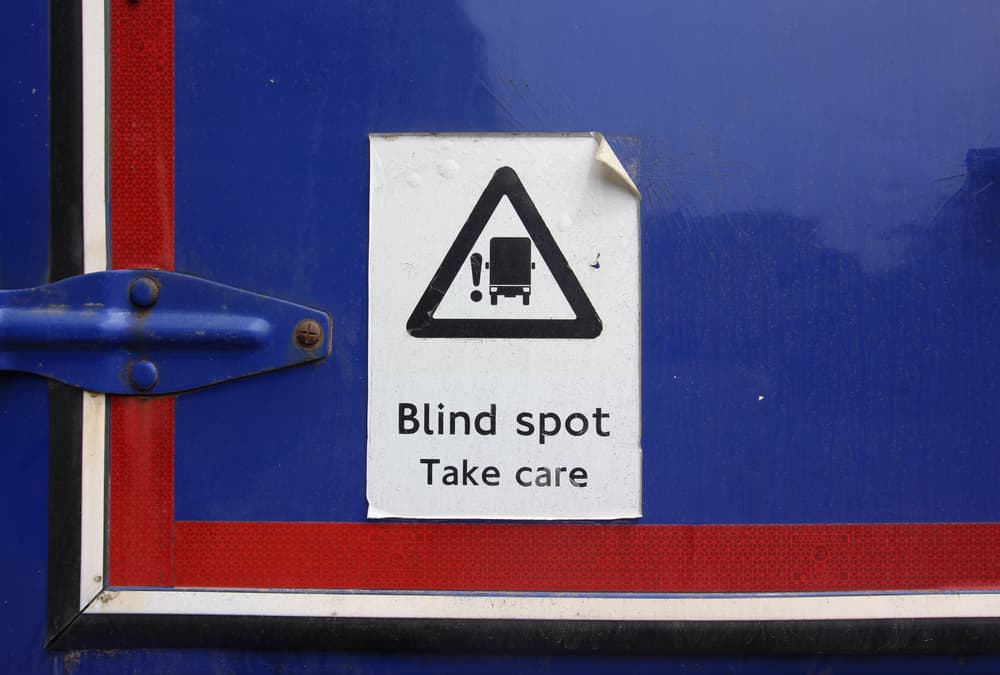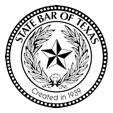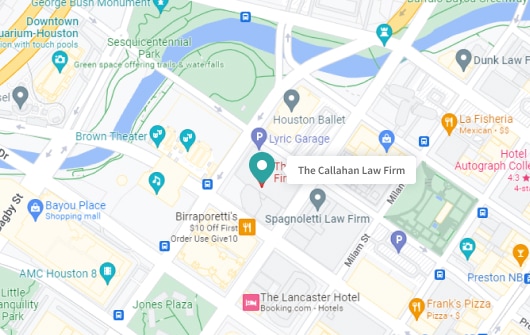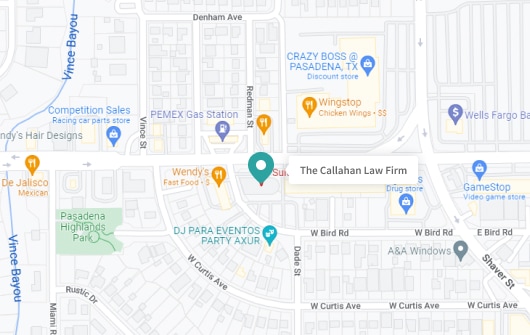Truck Blind Spot Accident Attorney in Houston

Houston is a vital transportation hub, with millions of trucks and tractor-trailers passing through from every direction each year. Unfortunately, this means blind spot truck accidents and other truck wrecks happen all-too-frequently in Houston. A common cause of these collisions is truck drivers who fail to properly check blind spots before maneuvering while attempting to change lanes, turn or back up.
If you have been injured in a Houston blind spot truck accident, you could be entitled to compensation for your losses. The truck accident lawyers of The Callahan Law Firm can help you seek justice if a negligent truck driver has harmed you.
Contact us for a free case review to learn more about your legal options.
What Are Blind Spots or No-Zones on Semi-Trucks?
Every vehicle has blind spots. A blind spot is an area where the driver has little or no visibility. Most of today’s vehicles are equipped with rearview and side-view mirrors, which provide drivers with a wider view of their surroundings. Many newer vehicles also have backup cameras and special sensors that effectively monitor blind spots.
Semi-trucks are much larger than the average vehicle, so truck drivers must contend with correspondingly large blind spots. Their side mirrors typically have a flat portion as well as a convex or curved portion that allows a wider view of spaces to the side of the truck and trailer when properly checked. Unfortunately, crashes happen when the truck driver does not adequately check the side view mirrors or take other precautions before attempting to change lanes or make a turn.
The Federal Motor Carrier Safety Administration (FMCSA) calls the blind spots around a large truck “no-zones” since it’s incredibly dangerous for smaller vehicles. A significant number of large truck accidents in Houston and throughout Texas happen when truck drivers fail to monitor their blind spots properly.
Where Are the Blind Spots Around a Truck?
How many no-zones do trucks have, and where are they? According to the FMCSA, the four primary blind spots around large trucks include:
- The front no-zone – Large trucks have massive cabs that sit much higher up off the road than most vehicles, which means a large section of the road immediately in front of a truck is often entirely invisible to the driver. The frontward blind spot on a truck can extend up to 20 feet in front of the cab. Because trucks take longer to stop than cars, the front “no-zone” is even bigger.
- The right-hand no-zone – The right-hand no-zone is one of the most pronounced blind spots for truck drivers. This no-zone extends backward at an angle from the driver’s right-hand side-view mirror, stretching across up to three lanes of traffic.
- The left-hand no-zone – Similar to the right-hand no-zone, the left-hand no-zone extends backward at an angle from the left-hand side-view mirror. Because U.S. truck drivers sit on the left, this no-zone is slightly smaller than the right-hand no-zone, but it can still stretch across up to two full lanes of traffic.
- The rear no-zone – Most semi-trucks have no interior rear-view mirrors, and even if they did, the driver’s rear view would be blocked by the trailer or other cargo being hauled. This large rear blind spot creates a no-zone behind large trucks that can extend up to 30 feet directly behind the end of a truck’s trailer.
Causes of Blind Spot Truck Crashes in Houston
Like any motor vehicle crash, a blind spot truck accident in Houston can be caused by various factors. However, many truck accidents happen due to simple driver negligence. Common causes of blind spot truck wrecks in Houston include:
- Distracted driving – Truckers who are absorbed in texting, trying to figure out their route, or other distractions have less attention focused on blind spots and are more likely to change lanes or drift into another lane and cause a crash.
- Reckless driving – Truck drivers who speed, tailgate, or drive aggressively have less room for error and less time to see and react to other vehicles in their no-zones.
- Driving under the influence – When truck drivers are drunk or under the influence of drugs while behind the wheel, they often have trouble monitoring their surroundings, including no-zones.
- Driver fatigue – Extreme fatigue can be just as impairing as drugs or alcohol, according to the CDC. Drowsy truck drivers are especially likely to be oblivious to their blind spots.
- Driver inexperience – Truck drivers with limited experience are more likely to commit driving errors, such as the failure to monitor blind spots routinely.
Common Types of Truck Blind Spot Accidents
When truck drivers fail to keep a close eye on their blind spots, the following types of accidents can occur:
- Rear-end crashes – Truck drivers can slam into the rear ends of vehicles in their front no-zones, or vehicles in rear no-zones when backing.
- Sideswipe wrecks – Drivers who ignore their left or right no-zones can hit the sides of smaller vehicles to either side.
- T-bone collisions – Negligent drivers who fail to check their front blind spots before proceeding through intersections can broadside or “T-bone” smaller cars.
- Underride accidents – If a truck driver fails to check their blind spots before turning or merging, smaller vehicles can become wedged under the trailer.
Who Is at Fault for a Blind Spot Truck Accident?
A negligent truck driver may be held liable in a Houston blind spot truck accident case, but other parties may also share responsibility. Any of the following parties could be at fault for a blind spot truck crash:
- The truck driver – The driver of a truck involved in a blind spot accident will almost always be at fault – either completely or partially. Truck drivers must undergo extensive training and testing to learn how to operate their rigs safely. They are required to have a special license – a commercial driver’s license – and are thus professional drivers. When these professional drivers neglect to apply what they have learned, they should be held responsible for the injuries and damages they cause when a blind spot truck wreck happens.
- The trucking company – The trucking company that hired the driver – either as an employee or as an independent owner-operator – is responsible for the negligent acts of its driver. And when a trucking company hires a driver who is not qualified or has a history of unsafe driving, that company should be held responsible.
- A manufacturer of a tractor truck or trailer – Truck and trailer manufacturers could also be responsible if the negligent design or manufacturing caused or contributed to the injuries. For example, underride accidents where a passenger vehicle goes underneath a trailer all too often result in catastrophic injuries to people in the vehicle. These type of crashes are preventable if trailer manufacturers would provide underride protection on the sides of their trailers. Unfortunately, they choose not to even though in many parts of the world including Europe, trailers must be equipped with underride protection.
Contact Our Experienced Houston Truck Accident Lawyers Today
The Houston truck accident attorneys at The Callahan Law Firm are ready to help you pursue the compensation you are owed if you were injured in a blind spot accident involving a truck or tractor-trailer. Contact us today to discuss the specifics of your crash and how we can help.











